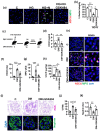Neutrophil Extracellular Traps Promote NLRP3 Inflammasome Activation and Glomerular Endothelial Dysfunction in Diabetic Kidney Disease
- PMID: 35889923
- PMCID: PMC9320009
- DOI: 10.3390/nu14142965
Neutrophil Extracellular Traps Promote NLRP3 Inflammasome Activation and Glomerular Endothelial Dysfunction in Diabetic Kidney Disease
Erratum in
-
Correction: Gupta et al. Neutrophil Extracellular Traps Promote NLRP3 Inflammasome Activation and Glomerular Endothelial Dysfunction in Diabetic Kidney Disease. Nutrients 2022, 14, 2965.Nutrients. 2023 May 23;15(11):2429. doi: 10.3390/nu15112429. Nutrients. 2023. PMID: 37299604 Free PMC article.
Abstract
Diabetes mellitus is a metabolic disease largely due to lifestyle and nutritional imbalance, resulting in insulin resistance, hyperglycemia and vascular complications. Diabetic kidney disease (DKD) is a major cause of end-stage renal failure contributing to morbidity and mortality worldwide. Therapeutic options to prevent or reverse DKD progression are limited. Endothelial and glomerular filtration barrier (GFB) dysfunction and sterile inflammation are associated with DKD. Neutrophil extracellular traps (NETs), originally identified as an innate immune mechanism to combat infection, have been implicated in sterile inflammatory responses in non-communicable diseases. However, the contribution of NETs in DKD remains unknown. Here, we show that biomarkers of NETs are increased in diabetic mice and diabetic patients and that these changes correlate with DKD severity. Mechanistically, NETs promote NLRP3 inflammasome activation and glomerular endothelial dysfunction under high glucose stress in vitro and in vivo. Inhibition of NETs (PAD4 inhibitor) ameliorate endothelial dysfunction and renal injury in DKD. Taken together, NET-induced sterile inflammation promotes diabetes-associated endothelial dysfunction, identifying a new pathomechanism contributing to DKD. Inhibition of NETs may be a promising therapeutic strategy in DKD.
Keywords: NLRP3 inflammasome; diabetic kidney disease; endothelial dysfunction; glomerular endothelial cells; glomerular filtration barrier disruption; neutrophil extracellular traps.
Conflict of interest statement
The authors declare no conflict of interest.
Figures




References
-
- Pantalone K.M., Hobbs T.M., Wells B.J., Kong S.X., Kattan M.W., Bouchard J., Yu C., Sakurada B., Milinovich A., Weng W., et al. Clinical characteristics, complications, comorbidities and treatment patterns among patients with type 2 diabetes mellitus in a large integrated health system. BMJ Open Diabetes Res. Care. 2015;3:e000093. doi: 10.1136/bmjdrc-2015-000093. - DOI - PMC - PubMed
MeSH terms
Substances
Grants and funding
- IS-67/8-1, IS-67/11-1, IS-67/22-1, SFB854/B26, RTG2408/P7&P9 to B.I., SFB854/A01, ME-1365/7-2, ME1365/9-2 to P.R.M., RTG2408/P5, SH 849/1-2 to K.S., KO 5736/1-1 to S.K., and Projektnummer 236360313 - SFB 1118 to BI/Deutsche Forschungsgemeinschaft
- SPMD to K.S and by funds of the Medical Faculty of the University of Leipzig/Stiftung Pathobiochemie und Molekulare Diagnostik
LinkOut - more resources
Full Text Sources
Medical

